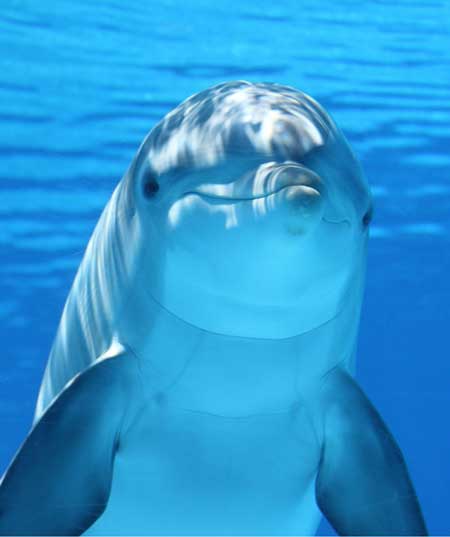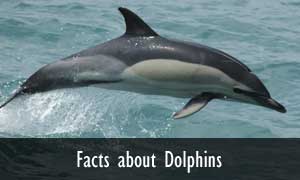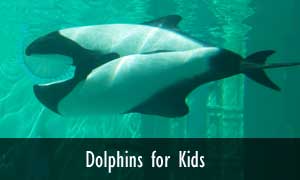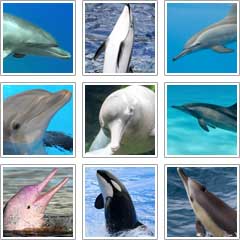Dolphin Information
Interesting Information About Dolphins. Habitat, distribution, feeding, reproduction, anatomy and more.
Read More…
Types of Dolphins
There are 43 species of dolphins found in the world.There are 38 marine dolphins, and 5 river dolphins.
Read More…
Dolphin Conservation
Dolphins may be well loved by many humans, but they are also at risk due to the efforts of humans.
Read More…
Dolphin Information, Anatomy, Feeding, Communication, Reproduction, Predators,Echolocation,
Language and Conservation. Bottlenose Dolphins, Spinner Dolphins, Amazon Pink Dolphins.
Introduction to dolphins
Dolphins are aquatic mammals that belong to the infraorder “Cetacea” a group of animals that includes whales, dolphins, and porpoises. They also belong to the parvorder “Odontoceti,” which are the toothed cetaceans, but taxonomically speaking, dolphins are an informal group, composed by most toothed cetaceans but excluding whales and porpoises.
There are 43 different species of dolphins identified. 38 of them are oceanic dolphins which are those that most people know and five species of river dolphins. The families included as “dolphins” are the oceanic and river dolphins:
– Delphinidae (Oceanic dolphins)
– Platanistidae (Indus and Ganges river dolphins)
– Iniidae (Amazon river dolphins)
– Pontoporiidae (La Plata river dolphins)
– Lipotidae (Baiji or Chinese river dolphins)
Regardless the place they live, Dolphins have to reach the surface of the ocean to breathe at different time intervals. This cycle can last up to 30 minutes in some large species. The skin color of dolphins is grayish-blue, but it can also be black, white, light gray, blueish and even pink or the combination of those colors varying according to the species. However, in every case, their skin is very sensitive to impacts and other elements that could be in the water.
Even though some dolphin species have up to 100 teeth, they don’t use them for chewing. They use their teeth only to hold the fish and then swallow them. Large dolphins like the Orca can consume up to 500 pounds of fish per day. The pods usually work as a team to surround a school of fish and get them as packed as possible. Afterward, they plow through the middle of the fish concentration and eat as much as they need.
They even take turns doing this so the fish do not disperse and they all have the opportunity to get the food they require. This hunting technique is just one of the many different types of feeding strategies that they may use to reduce the effort of catching fish.
“Dolphins have been interacting with humans for as long as we have known of their existence”.
If we talk about charismatic animals, dolphins are probably on the podium. Enormously popular, significantly intelligent and scientifically sophisticated, they are amidst the most beloved animals among people. Dolphins have captured the human imagination in a variety of ways. They are curious, form strong bonds within their pod, and they have been known to help their peers and people in a variety of circumstances.
A group of dolphins is called a pod.
Types of Dolphins

Dolphins Species.
There are more than 40 species of dolphins, but the number keeps changing as science learns more about these marine mammals. Most dolphins are part of the Delphinidae family, which includes those living in the ocean, but some other species live in rivers and have a different taxonomic classification. Definitively, the best known of all the species is the bottlenose dolphin.
Among those dwelling in freshwater rivers, probably the best-known is the Amazon River Dolphin or Boto, also popular because of its pink skin.
It is astounding the size variety of dolphin species. While the largest, the Orca, can weigh about 11 tons and reach up to 30 feet long, the smallest species are only 90 pounds and 4 feet long. Between those two limits, there is an assortment of weights and lengths. The living habitat of each species plays a significant role in its overall size as the feeding habits sometimes make size differences even within the same species.
Facts about Dolphins
Where do dolphins live?
Dolphin Intelligence.
When talking about these cetaceans, how to forget its excellent cognitive ability? Dolphins differ from most animals because of their capacity to establish social ties in a way comparable to that of humans. For example, if one of them is injured or sick, the others help him to reach the surface so he can breathe. Their social structures are among the most remarkable aspects of these creatures.
Dolphin Evolution.
Even though we have significant information about dolphins today, there are still many questions about their origin. Some theories come from the fossils discovered like the hypothesis that millions of years ago dolphins were much smaller than they are today. Many experts also believe that echolocation is a specialization result of the evolution process. Only time, new fossils and future technology will help us to get definite answers about the evolution of dolphins.
Dolphins and Ancient Civilizations.
Archaeological evidence indicates that dolphins had contact with ancient civilizations who had access to the sea. And if their behavior has not changed much over the centuries, they likely interacted with them.
The word “dolphin” seems to come from the Greek δελφίς (delphis), a term related to the word δελφύς (delphus), of the same language that means “womb.” According to Greek mythology, the god Apollo arrived at Delphi as a dolphin.
Dolphin Echolocation
The evolution process of dolphins provided them with this sense that allows them to survive and succeed in the aquatic environment. Dolphins have an organ that emits sound waves, and they can interpret the returning echo to detect prey and dangers.
Research proved that echolocation is an essential element of dolphin life. It allows them to get information and details about their surrounding by identifying bounced sound waves.
It is a complex function that starts in the melon, an organ located in the head of the dolphin, which emits sound waves and detects their return when bounced back by objects or animals, giving the brain the elements to interpret them and get vital information about prey or dangers. It works very similarly to the radar. Would you be more efficient with a radar in your head?
Dolphin Anatomy
The characteristics of these cetaceans are very diverse. If they can be generalized in any way, the body of the dolphins is fusiform, hydrodynamic and with fluid movements. Most of them have an elongated snout, dozens of small functional teeth, not to chew but to hold the prey and a single blowhole in the dorsum to get oxygen from the air.
On its back, they have a dorsal fin, and at the end, there is a caudal fin that moves from bottom to top which allows them to swim gracefully in the water.
Their skin is usually smooth, often gray or bluish and free of fur, but some show unimagined color patterns. Thanks to the shape of their body and the features described above, they can perform exceptional acrobatic maneuvers in the air that include majestic turns and jumps.
The body of a dolphin is designed to help them move through the water quickly and without exerting enormous amounts of energy. They rely on their pectoral flippers and the fluke (tail) to navigate through the ocean.
Dolphins have excellent vision, and they can see whatever is close to them either in the water or above the surface. They also have good hearing, with a capacity of hearing up to 10 times better than humans. Their sense of touch is very acute, and they use it for bonding with other members of their pods. As we can see, they rely on a combination of their senses to avoid danger, find food, and socialize. The smell isn’t well developed for them, though.
Dolphin Conservation
Not everything is as positive as we would like. In today’s world, many species are experiencing a rapid population decline in the wild, mainly as a result of anthropogenic activities; which means those related to humans.
Dolphins are not the exception, as many other animals, the future of various species of dolphins is at risk due to habitat degradation, problems finding food, pollutants in the water, injuries or death due to getting entangled in fishing nets and even fatal wounds made by boat propels. There are conservation efforts to protect these species so they can have a future, but they do not seem enough for some species such as the Baiji which is considered already extinct. The average lifespan for a dolphin in the wild is 17 years. However, some have been documented to live up to 50 years!
Understanding and respecting them as living beings is a mission that does not have to be complicated. The beginning can be as simple as getting information about the vast and fascinating world of dolphins.
How do dolphins sleep?
Dolphins and Humans
Dolphins have been interacting with humans for as long as we have known about their existence. However, during this time, their most dangerous predator and the only one that has dramatically reduced their population is the human. Even though we all agree that Dolphins are fantastic creatures that seem to be intelligent and friendly, we still are a huge threat to them.
A deeper knowledge and further information about dolphins is the first step towards a better conservation and understanding of these amazing cetaceans.
Trying to provide readable-friendly information about Dolphins, we include articles like “dolphin way of life,” which contains the information about daily dolphin activities, for example, “what do dolphins eat?” or “social relationships,” among others.
Regarding the basic information about dolphins, you will find detailed data about dolphin reproduction, the way they hunt and how they communicate. At the anatomic level, a particular analysis of the echolocation, their basic anatomy and physiology.
The section related to humans is devoted to the relationship between dolphins and humans, including articles which describe encounters with them like the incredible rescues of humans by dolphins. Also, we include a section about how dolphins impacted our culture reflecting this in movies, books and many other ways of expression that have existed for centuries including even the most prominent ancient cultures and civilizations like the Greek and Roman which included dolphins in their mythology.
Finally, the section for kids created thinking in little kids, tries to provide them essential information about dolphins through educative activities like puzzles, coloring pages or how to draw a dolphin with the idea to make kids aware of dolphin conservation in a funny way.
Dolphins vs. Baleen Whales
Dolphins have teeth.
Dolphins have a single blowhole.
Dolphins tend to be smaller.
Dolphins use echolocation.
vs
Whales have beards.
Whales have two blowholes.
Whales grow a few more meters.
Whales do not have echolocation sense.
Dolphin species
Family Delphinidae, Oceanic Dolphins
Genus Delphinus
Long-Beaked Common Dolphin, Delphinus capensis
Short-Beaked Common Dolphin, Delphinus delphis
Genus Tursiops
Common Bottlenose Dolphin, Tursiops truncatus
Indo-Pacific Bottlenose Dolphin, Tursiops aduncus
Burrunan Dolphin, Tursiops australis (discovered in 2011)
Genus Lissodelphis
Northern Rightwhale Dolphin, Lissodelphis borealis
Southern Rightwhale Dolphin, Lissodelphis peronii
Genus Sotalia
Guiana dolphin, Sotalia guianensi
Genus Sousa
Chinese White Dolphin, Sousa chinensis
Atlantic Humpbacked Dolphin, Sousa teuszii
Genus Stenella
Atlantic Spotted Dolphin, Stenella frontalis
Clymene Dolphin, Stenella clymene
Pantropical Spotted Dolphin, Stenella attenuata
Spinner Dolphin, Stenella longirostris
Striped Dolphin, Stenella coeruleoalba
Genus Steno
Rough-Toothed Dolphin, Steno bredanensis
Genus Cephalorhynchus
Chilean Dolphin, Cephalorhynchus eutropia
Commerson’s Dolphin, Cephalorhynchus commersonii
Heaviside’s Dolphin, Cephalorhynchus heavisidii
Hector’s Dolphin, Cephalorhynchus hectori
Genus Grampus
Genus Lagenodelphis
Fraser’s Dolphin, Lagenodelphis hosei
Genus Lagenorhynchus
Atlantic White-Sided Dolphin, Lagenorhynchus acutus
Dusky Dolphin, Lagenorhynchus obscurus
Hourglass Dolphin, Lagenorhynchus cruciger
Pacific White-Sided Dolphin, Lagenorhynchus obliquidens
Peale’s Dolphin, Lagenorhynchus australis
White-Beaked Dolphin, Lagenorhynchus albirostris
Genus Orcaella
Australian Snubfin Dolphin, Orcaella heinsohni
Irrawaddy Dolphin, Orcaella brevirostris
Genus Peponocephala
Melon-headed Whale, Peponocephala electra
Genus Orcinus
Killer whale (Orca), Orcinus orca
Genus Feresa
Pygmy Killer Whale, Feresa attenuata
Genus Pseudorca
False Killer Whale, Pseudorca crassidens
Genus Globicephala
Long-finned Pilot Whale, Globicephala melas
Short-finned Pilot Whale, Globicephala macrorhynchus
River Dolphins
Family Platanistidae
Ganges and Indus River Dolphin, Platanista gangetica
Ganges River Dolphin (or Susu), Platanista gangetica gangetica
Indus River Dolphin (or Bhulan), Platanista gangetica minor
Family Iniidae
Amazon River Dolphin (or Boto), Inia geoffrensis
Family Lipotidae
Baiji (or Chinese River Dolphin), Lipotes vexillifer
Family Pontoporiidae
Frequently Asked Questions about Dolphins

How Are Dolphin And Whales Are Alike?
How Are Dolphins Important To The Ecosystem?
How Are Dolphins Important To The Environment?
How Bottlenose Dolphins Give Birth?
How Do Bottlenose Dolphins Communicate?
How Do Dolphins Catch Their Food?
How Do Dolphins Protect Themselves?
How Do Dolphins Raise Their Young?
How Do Pink River Dolphins Reproduce?
How Do You Know Dolphins Are Mammals?
How Long Do Wild Dolphins Tend To Live?
How Long Dolphins Carry There Young?
How Many Species Of Dolphins Are In The World?
What is the Attraction To Dolphins?
What Are The Common Dolphins Predators?
What Climate Do Dolphins Like To Live In?
What Do Pacific White-Sided Dolphins Eat?
What Do Bottlenose Dolphins Look Like?
What Does It Take To Rescue Dolphins?
What Is A Group Of Dolphins Called?
What Is Done To Protect The Common Dolphin?
What Is It Called When A Dolphin Makes Noise?
What Is The Difference Between A Dolphin And A Porpoise?
What Is The Hole On Top Of The Dolphin For?
What Is The Life Span Of A Dolphin?
What Is The Scientific Name For The Striped Dolphin?
What Species Are Related To The Bottlenose Dolphin?
What Type Of Herring Do Dolphins Prey Upon?
What Type Of Mammals Are Dolphins?
What Types Of Bottlenose Dolphins Are There?
Where Are Bottlenose Dolphins Found?
Where Are Yangtze River Dolphins Found?
Where do Bottlenose Dolphins Live?
Where Do Bottlenose Dolphin Go during Summer Months?
Where Do Bottlenose Dolphin Go during Winter Months?
Where Do Chinese White Dolphin Live?
Why Are Dolphins Endangered Animals?
Why Are Dolphins Important To Humans?
Why Are Dolphins So Popular With Humans?
Why Are Pink River Dolphins Endangered?
Why Baby Dolphins Swim So Close To Their Mother?
Why Do Dolphins Jump In The Air?
Why Do Dolphins Jump Out Of The Water?
Why Dolphins Are Brought Into Captivity?




